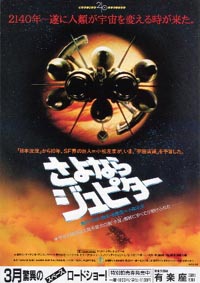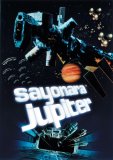| Reviews & Columns |
|
Reviews DVD TV on DVD Blu-ray 4K UHD International DVDs In Theaters Reviews by Studio Video Games Features Collector Series DVDs Easter Egg Database Interviews DVD Talk Radio Feature Articles Columns Anime Talk DVD Savant Horror DVDs The M.O.D. Squad Art House HD Talk Silent DVD
|
DVD Talk Forum |
|
|
| Resources |
|
DVD Price Search Customer Service #'s RCE Info Links |
|
Columns
|
|
|
Sayonara Jupiter
An adaptation by Toho of Sakyo Komatsu's novel The Submersion of Japan (Nippon chinbotsu, 1973) was hugely successful within Japan; it was the highest grossing film that year, earning more than twice both the second-ranked domestic film and the top-grossing foreign release (The Poseidon Adventure), but another Komatsu film the following year, ESPY, flopped badly. Kinji Fukasaku's $16 million film of Komatsu's Virus (Fukkatsu no hi, or "Resurrection Day," 1980), a Kadokawa production released through Toho, was nearly as popular as The Submersion of Japan however (if much less profitable), and by this time the bestselling author had enough clout to demand that he not only adapt his novel of Sayonara Jupiter himself, but that he co-produce and co-direct it as well.
Set in the year 2125, when space travel and colonization within the solar system is commonplace, Dr. Eiji Honda (Tomokazu Miura) - the character apparently so named in honor both Tsuburaya and director Ishiro Honda - is a scientist working on a project to transform Jupiter into a "second sun," and thus provide energy for colonies established on the outer planets. Plans for this are opposed by a radical religious cult (founded by a bearded former pop star), who repeatedly attempt to sabotage Honda's efforts aboard Minerva, a series of research vessels orbiting Jupiter.
The destruction of the Space Arrow probe reveals that a wayward black hole is heading toward the solar system and which will destroy all life, but Honda hits upon the idea of altering his "solarization" plans for Jupiter and instead send Jupiter into the black hole, thus altering its trajectory.
The film is like nothing made by the Japanese film industry before or since. Like an aging marathon runner, Toho's visual effects department, which had been as good as any in the world in the late-1950s and early-'60s, had become downright quaint in the wake of 2001: A Space Odyssey (1968) and Star Wars (1977). The studio's blatant effort to steal the latter film's thunder, 1977's The War in Space (Wakusei daisenso), was embarrassingly bad in all departments, but Sayonara Jupiter offered visuals created with the same motion-control, blue screen technology employed by Lucasfilm's Industrial Light & Magic. Though inconsistent, by the standards of the time most of Sayonara's special effects are as good as anything that could have been produced in Hollywood.
Unfortunately, for all its opulence Sayonara Jupiter is singularly uninvolving when it's not horribly misguided and derivative. Though it was quite popular - it tied for third on the year's list of domestic releases - it was a failure relative to its cost.
Many of the problems appear to stem from basic creative differences between Toho's desire to produce a Star Wars-style space adventure, and Komatsu's insistence on something closer to written science fiction, with concepts and characters that might work in novel form but which come off as ludicrous cinematically.
One gets the sense that Komatsu didn't get along with veteran producer Tomoyuki Tanaka and/or co-director Koji Hashimoto (1984's The Return of Godzilla/Godzilla: 1985), and in an attempt to reconcile both commercial needs and artistic ambitions everything everybody wanted was left in the final cut of the film, which runs a grueling two hours and nineteen minutes (and feels even longer).
The sluggish picture just hangs there. Honda may be a stereotypical sci-fi hero, but everyone else is pure cardboard. Part of the reason for this was the peculiar decision to cast non-Asians in about 85% of the speaking parts, and to shoot nearly that much of the picture in English. Honda will address Caucasian characters in Japanese, who usually answer in English (which in turn was subtitled into Japanese for the theatrical release version). This daffy approach might have worked had the English-speaking cast consisted of professional actors, but Toho seemingly grabbed people at random off the street. Dangely Diane (aka Diane d'Angely) and Rachel Huggett are the female leads, the former as Honda's ex-girlfriend turned religious radical, the latter as a scientist in mourning after the death of her would-be lover, Dr. Inoue (Akihiko Hirata). D'Angely is awful beyond all measure, though in her defense her love scenes with Honda are so badly written it's doubtful the combined talents of Isabelle Huppert, Isabelle Adjani, and Juliette Binoche could have made the part appear anything other than ridiculous. Huggert, who mouths Japanese but clearly is dubbed, comes off slightly better, though wooden. Another character, a Wesley Crusher whiz-kid type named Carlos (Marc Pinonnat), speaks fluent Japanese and gives probably the best performance among the non-Japanese cast.
Besides Hirata (1954's Gojira), in his last film - he died of cancer soon after this was released - Japanese actor Masumi Okada has a small, English-speaking role while longtime Toho star Hisaya Morishige turns up as the President of the Earth Federation, adorned in unconvincing white wig and flowing beard. Besides Morishige and Miura, more famous at the time as the husband of Momoe Yamaguchi, there are no stars.
A bigger problem is the film's depressing and wholesale lifting of visual designs and sequences from western productions. The approach to the Solarization ships hovering over Jupiter shamelessly steals miniature designs and camera angles whole cloth from both 2001 and Star Wars. One live action set is identical to (and shot from the same angle as) HAL 9000's control center in 2001 while a zero-gravity lovemaking scene (complete with nudity) emulates the last scene in Moonraker. Though the film offers much that is new, Special Effects Director Koichi Kawakita (in his first major assignment in that role) depressingly feels the need to clone the work of others simply because he finally has been given the hardware to do so.
First unit sequences are equally derivative or smack of box office concessions. The idea of a doomsday cult determined to destroy the solar system in order to save it is impressively prophetic. Its pop star-turned-guru, Peter (Paul Taiga), eerily resembles Shoko Asahara, the leader of the Aum cult that created a nationwide panic after releasing Sarin gas into Tokyo's subway system in 1995, and like Asahara, Peter deceptively denies playing any role in his followers' efforts to sabotage the Jupiter Project. Unfortunately, the film's producers saw in these scenes the chance to insert drippy commercial pop songs, to say nothing of a ludicrous sequence that, of all things, rips off Jaws (1975).
Video & Audio
Sayonara Jupiter is presented in an excellent 16:9 enhanced transfer that crops the 1.85:1 release (lenses by Panavision) slightly on the top and sides to about 1.8:1. The original audio track makes excellent use of Dolby Stereo. An alternate track, entirely in English, is badly dubbed with Australian accents and has unimpressive mono audio. The optional English subtitles are generally quite good.
Extra Features
Supplements include Making of Sayonara Jyupitaa, a 30-minute, full-frame behind-the-scenes documentary apparently culled from a VHS source, as it retains Toho Video's logo from the mid-1980s. The show focuses almost entirely on the film's technical aspects, but offers little in the way of interviews and mainly shows first unit and effects sequences being filmed.
An impressive Photo Gallery is both extensive and helpfully captioned, while a trailer for the film is both 16:9 enhanced and subtitled. About the Film is a brief essay, written in 2003, by Komatsu, that hints at friction between him and producer Tomoyuki Tanaka, while Another Sayonara Jupiter is an embarrassingly indulgent and self-serving essay by Yuko Weisser about her pals putting on an Osaka stage production based on the film. As with the unfortunate books she co-authored with husband Thomas Weisser, the essay is rife with clumsy grammatical and factual errors. (She claims, for instance, that Sayonara Jupiter "owes more than a passing acknowledgement to Peter Hyam's [sic] 2010," a neat trick considering that film was released nearly nine months after the Japanese picture.)
Parting Thoughts
Sayonara Jupiter will intrigue and frustrate fans of Japanese fantasy cinema in equal measure, while mainstream American audiences will find it insufferably dull and unoriginal.
Film historian Stuart Galbraith IV's most recent essays appear in Criterion's new three-disc Seven Samurai DVD and BCI Eclipse's The Quiet Duel.
|
| Popular Reviews |
| Sponsored Links |
|
|
| Sponsored Links |
|
|
| Release List | Reviews | Shop | Newsletter | Forum | DVD Giveaways | Blu-Ray | Advertise |
|
Copyright 2024 DVDTalk.com All Rights Reserved. Legal Info, Privacy Policy, Terms of Use,
Manage Preferences,
Your Privacy Choices | |||||||
















